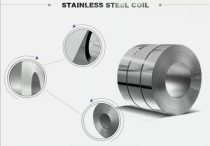There are several questions that arise when considering whether to heat treat a 301 stainless steel coil. Among these are what heat treatment types are appropriate for a particular alloy, how 301 is austenitic, and whether or not it is suitable for spring applications. The following article will shed light on these questions.
Let’s start with a definition of austenitic. An austenitic metal is one that exhibits work hardening during deformation. The high C content of this type of steel is not recommended for applications that require extremely high tensile strength or abrasion resistance.
301 stainless steel coil is heat-treated
Stainless steel 301 coil is an austenitic type of material, with good corrosion resistance. Precision Steel stocks a wide variety of 301 stainless steel in different tempers. 301 stainless steel is a nonmagnetic material when annealed. Due to its corrosion resistance and high strength, it is the ideal material for a variety of applications. Here’s a closer look at how this metal can be used.

301 stainless steel coils are wrought alloys with lower chromium and nickel content than Form 302. This alloy produces a product with increased ductility and works faster than type 302, but is not hardened. It stocks in a variety of gauges and widths and is available in various temperature ranges. It has a similar corrosion resistance as Type 304 and 302 stainless steel.
301 stainless steel is austenitic
Stainless steel 301 is known for its outstanding corrosion resistance and good strength. This type of austenitic stainless steel has a nominal composition of 17 percent chromium and 7 percent nickel. These alloys offer good welding and forming properties and are well suited for various applications. The different tempers available in 301 stainless steel are Hard, Half Hard, and Soft. The following table provides some additional information regarding 301 stainless steel.
Stainless steel 201 is an austenitic-chromium-nickel strip coil that exhibits high tensile strength and ductility when cold-worked. This alloy is also available with tempering if needed. 301 stainless steel flat-rolled coil is non-magnetic in the annealed condition and magnetic after cold working. It is used for blanking, bending, stretching, and drawing. Its oxidation weight gain is ten milligrams per square centimeter of material every 1,000 hours. It is also suitable for deep drawing but needs intermediate annealing to reach its hardness level.
301 stainless steel is prone to work hardening during deformation
Type 301 is an austenitic stainless steel, and its structure is nearly complete. This type is easy to work-harden by cold-forming. The steel hardens at a fast rate, and is magnetic during the deformation process. Unlike other types of steel, type 301 is not susceptible to annealing. Because of its high strength and good corrosion resistance, it is generally not used for applications that require extreme corrosive environments.
A 301 stainless steel coil is susceptible to work-hardening during deformation. This property makes it particularly suitable for places where material needs to be highly strong, such as in heavy machinery. However, it is important to note that the alloy is more prone to work-hardening than other grades. However, this does not mean that it cannot be used in other processes. Regardless of the alloy used, its superior strength is a determining factor in choosing the right material for your application.
301 stainless steel is a good material for springs
301 stainless steel coil is a great material for springs, but how does it work? Spring is made from a strip of stainless steel that has been coiled into a spiral shape. These strips are then stamped, deburred, or skived. Ulbrich is able to produce both types of coil. This strip can be either traverse wound or stamped.
Type 301 stainless steel is an austenitic chromium-nickel stainless steel that is typically available in cold-worked or annealed conditions. Because of its ductility, 301 is widely used in many industries with high-volume demands for springs. 301 stainless steel is also non-magnetic and annealed to a range of tempers, which makes it highly versatile.
301 stainless steel is a good material for stampings
The most common applications for 301 stainless steel coil include springs. These products require different qualities to function effectively, and the coiling process is one way to produce high-quality springs. Aside from coiling, other processes also play a role in the production of high-quality springs. In this article, we’ll look at a few other uses for 301 stainless strip and wire.
Stainless steel 301 coil is available in a variety of shapes and sizes, including cable and strip shapes. These coils can be cold-worked for higher hardness and strength. They also undergo a stress-relieving process before being delivered to a stamping manufacturer. In addition, 301 stainless steel coil has a wide range of temperatures, from 1/16 to Full Hard. Its high strength and ductility make it an excellent material for stampings and other products that require high-quality metal.
